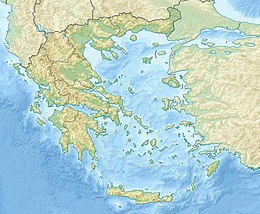Native name: Νάξος | |
|---|---|
 Port of Naxos (city) | |
| Geography | |
| Coordinates | 37°05′15″N 25°24′14″E / 37.08750°N 25.40389°E |
| Archipelago | Cyclades |
| Area | 430 km2 (170 sq mi) |
| Highest elevation | 1,003 m (3291 ft) |
| Highest point | Mt. Zeus |
| Administration | |
Greece | |
| Region | South Aegean |
| Regional unit | Naxos |
| Capital city | Naxos (city) |
| Demographics | |
| Demonym | Naxiot |
| Population | 18,904 (2011) |
| Pop. density | 44/km2 (114/sq mi) |
Naxos (/ˈnæksɒs, -soʊs/; Greek: Νάξος, pronounced [ˈnaksos]) is a Greek island and the largest of the Cyclades. It was the centre of the archaic Cycladic culture. The island is famous as a source of emery, a rock rich in corundum, which until modern times was one of the best abrasives available.[1]
The largest town and capital of the island is Chora or Naxos City, with 7,374 inhabitants (2011 census). The main villages are Filoti, Apiranthos, Vivlos, Agios Arsenios, Koronos and Glynado.
- ^ https://www.naxos.gr/emery-mines/?lang=en (viewed 01/07/2023).
